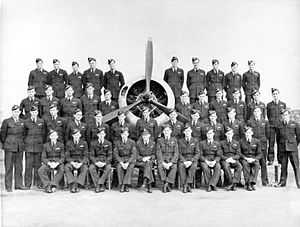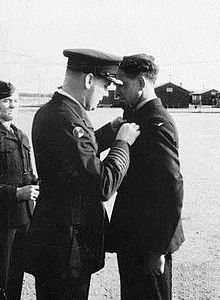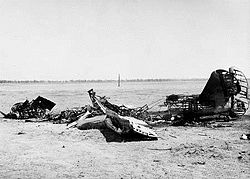- No. 5 Service Flying Training School RAAF
-
No. 5 Service Flying Training School RAAF 
Post-graduation group portrait of No. 33 Course at No. 5 SFTS in front of a Wirraway trainer, July 1943Active 1941–1946 Allegiance  Australia
AustraliaBranch  Royal Australian Air Force
Royal Australian Air ForceRole Advanced flight training Part of No. 2 Training Group Garrison/HQ RAAF Station Uranquinty No. 5 Service Flying Training School (No. 5 SFTS) was a Royal Australian Air Force flight training unit of World War II. Its role was to provide intermediate and advanced flight training to new pilots as part of Australia's contribution to the Empire Air Training Scheme. No. 5 SFTS was one of eight Service Flying Training Schools established by the RAAF to train aircrew during the war. It was formed at RAAF Station Uranquinty, New South Wales, in October 1941, and disbanded in February 1946. Its staff and equipment were employed to re-establish No. 1 Flying Training School, which transferred to RAAF Station Point Cook, Victoria, the following year.
Contents
History
RAAF aircrew training expanded dramatically following the outbreak of World War II, in response to Australia's participation in the Empire Air Training Scheme (EATS). The Air Force's pre-war flight training facility, No. 1 Flying Training School at RAAF Station Point Cook, Victoria, was supplanted in 1940–41 by twelve Elementary Flying Training Schools (EFTS), eight Service Flying Training Schools (SFTS), and Central Flying School (CFS).[1][2] While CFS turned out new flight instructors, the EFTS provided basic training to prospective pilots who, if successful, would go on to SFTS for further instruction that focussed on operational (or "service") flying.[1][3] The course at SFTS typically consisted of two streams, intermediate and advanced, and included such techniques as instrument flying, night flying, advanced aerobatics, formation flying, dive bombing, and aerial gunnery.[1][4] The total duration varied during the war as demand for aircrew rose and fell. Initially running for 16 weeks, the course was cut to 10 weeks (which included 75 hours flying time) in October 1940. A year later it was raised to 12 weeks (including 100 hours flying time), and again to 16 weeks two months later. It continued to increase after this, peaking at 28 weeks in June 1944.[4]
No. 5 Service Flying Training School (No. 5 SFTS) was formed at RAAF Station Uranquinty, New South Wales, in October 1941, and came under the control of No. 2 Training Group. The unit's inaugural commander was Group Captain Ulex Ewart, a graduate of the Royal Military College, Duntroon, who had been seconded to the Air Force and learnt to fly on the first cadet course at No. 1 Flying Training School in 1923.[5][6] At the time of its formation, No. 5 SFTS had a strength of 792 personnel, who were responsible for training about 200 pilots.[5] One of its original instructors was Flying Officer Bill Newton, later to be awarded the Victoria Cross for bombing raids in New Guinea.[7] Following the outbreak of the Pacific War in December 1941, the school's CAC Wirraway single-engined trainers were classified as Second Line (Reserve) aircraft in the defence of Australia[8]
No. 5 SFTS began flight training in February 1942 using 28 Wirraways. The unit grew over the next two years, and by early 1944 was operating 128 Wirraways, two de Havilland DH.84 Dragons, two de Havilland Moth Minors and a CAC Wackett. It typically graduated one course of pilots each month,[5] although the wastage rate sometimes exceeded 40 per cent.[9] Among its graduates was Len Waters, the first Australian Aboriginal military aviator, and the only one to serve as a fighter pilot in the RAAF during World War II.[1][10] As a training facility, No. 5 SFTS regularly suffered flying accidents.[5] Forty-two of its students died during the war, an average of around one per month.[9] A near miss involving more experienced pilots occurred at the school in December 1943, when aces Clive Caldwell and John Waddy, then instructors at No. 2 Operational Training Unit in Victoria, almost collided when they crossed paths during an aerobatics display over the base.[11] The amount of flying conducted by No. 5 SFTS declined throughout 1945 and its aircraft were being prepared for long-term storage by November. In February 1946 No. 5 SFTS was disbanded and its personnel and equipment were used to re-establish No. 1 Flying Training School (No. 1 FTS),[5] which had operated during the war as No. 1 Service Flying Training School before disbanding in 1944.[12] No. 1 FTS relocated to RAAF Station Point Cook in August 1947. No. 5 SFTS also spawned Care and Maintenance Unit (CMU) Uranquinty, to look after the surplus aircraft stored at the base. These were auctioned off in November 1948, and CMU was dissolved the following month.[5]
Notes
- ^ a b c d Stephens, The Royal Australian Air Force, pp. 67–70
- ^ Gillison, Royal Australian Air Force 1939–1942, p. 111
- ^ Gillison, Royal Australian Air Force 1939–1942, p. 97
- ^ a b Gillison, Royal Australian Air Force 1939–1942, p. 109
- ^ a b c d e f RAAF Historical Section, Units of the Royal Australian Air Force, pp. 107–108
- ^ Coulthard-Clark, The Third Brother, pp. 120, 192
- ^ Weate, Bill Newton VC, pp. 19–22
- ^ Gillison, Royal Australian Air Force 1939–1942, pp. 234–238
- ^ a b A different war: Australians in Bomber Command at Australian War Memorial. Retrieved on 24 February 2011.
- ^ Black Magic at Australia's War 1939–1945. Retrieved on 24 February 2011.
- ^ Alexander, Clive Caldwell: Air Ace, p. 156
- ^ RAAF Historical Section, Units of the Royal Australian Air Force, pp. 38–39
References
- Alexander, Kristen (2006). Clive Caldwell: Air Ace. Crows Nest, New South Wales: Allen & Unwin. ISBN 1741147050.
- Coulthard-Clark, Chris (1991). The Third Brother: The Royal Australian Air Force 1921–39. North Sydney: Allen & Unwin. ISBN 0044423071. http://airpower.airforce.gov.au/Publications/List/38/Historical-Titles.aspx?page=2.
- Gillison, Douglas (1962). Australia in the War of 1939–1945: Series Three (Air) Volume I – Royal Australian Air Force 1939–1942. Canberra: Australian War Memorial. OCLC 2000369. http://www.awm.gov.au/histories/second_world_war/volume.asp?levelID=67912.
- RAAF Historical Section (1995). Units of the Royal Australian Air Force: A Concise History. Volume 8: Training Units. Canberra: Australian Government Publishing Service. ISBN 0644428007.
- Stephens, Alan (2006) [2001]. The Royal Australian Air Force: A History. London: Oxford University Press. ISBN 0195555414.
- Weate, Mark (1999). Bill Newton VC: The Short Life of a RAAF Hero. Loftus, New South Wales: Australian Military History Publications. ISBN 1876439785.
Further reading
- Ilbery, Peter (2002). Hatching an Air Force: 2 SFTS, 5 SFTS, 1 BFTS Uranquinty and Wagga-Wagga. Maryborough, Queensland: Banner books. ISBN 1875593241.
Categories:- RAAF training units
- Military units and formations established in 1941
- Military units and formations disestablished in 1946
Wikimedia Foundation. 2010.


